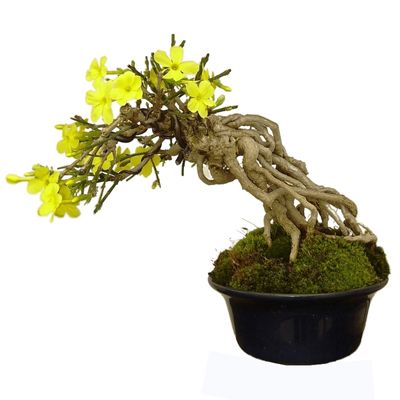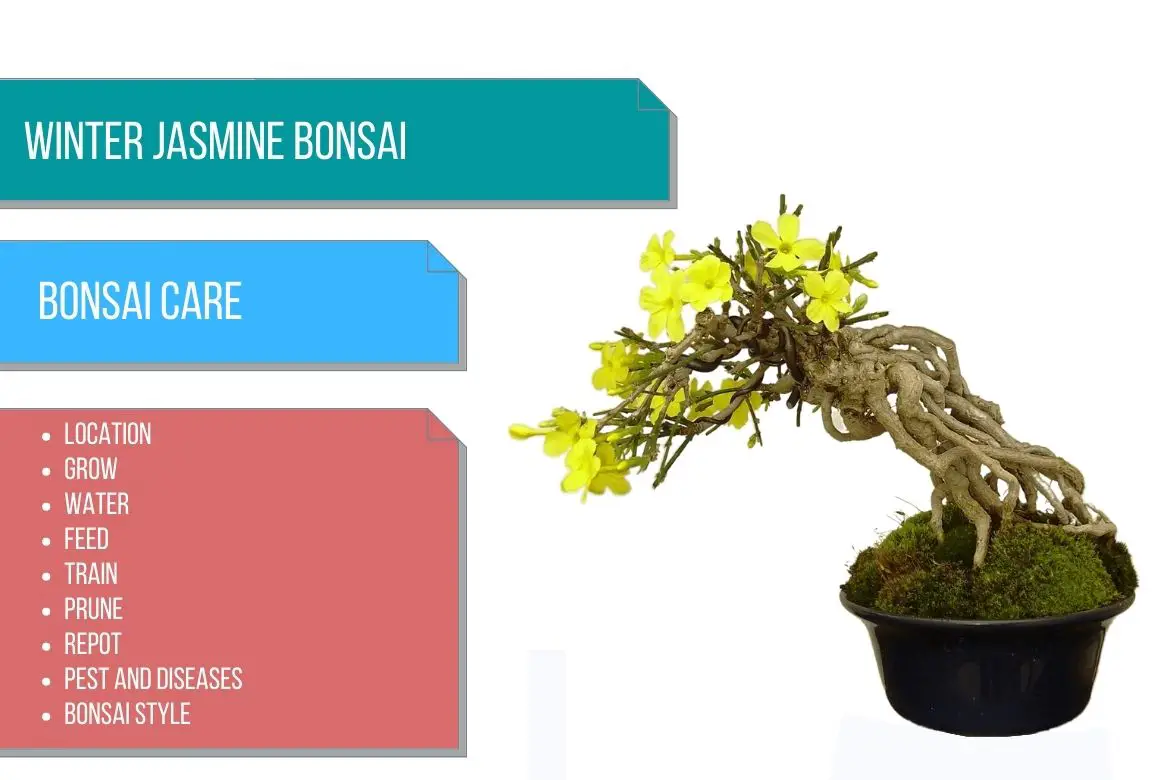
Winter jasmine
(Jasminum nudiflorum)
Country of Origin : Northern China
Bonsai Styles : Informal upright, slanting, semi-cascade, cascade, root-over-rock, exposed root
Zone : 6 – 9
Jasminum nudiflorum is a popular, deciduous, slow-growing flowering shrub. Winter jasmine (as its name implies) is one of the few shrubs that blooms during the winter months.
It has a rambling growth pattern with arched green branches that curve back towards the ground. As the branches mature they become thick and acquire a tree-like appearance.
Also, the shrub develops an impressive rough bark at a young age.
The leaves of the tree are dark green, oval and narrow at both ends. The leaf at the end of the stem is always longer than the other leaves on the stem. The stems are covered with leaves in spring and summer.
The scale of both leaves and flowers makes this attractive shrub especially suitable for growing as a flowering bonsai tree. It can be trained in many bonsai styles but informal and cascade styles are most common. Many bonsai growers also grow this as a small (shohin) and miniature (mame) bonsai trees.
Yellow, fragrant, star-shaped flowers bloom on bare, flexible, arching green stems. The flowers can emerge singly or in small clusters.
Blooms often begin in late autumn and continue into late winter or early spring. Flowers are borne from previous years’ growth.
Read more about other bonsai trees species in : Types of bonsai tree
Best location to keep Winter jasmine bonsai tree
You can keep the winter jasmine bonsai tree in full sun or partial shade throughout the growing season. If you have a small bonsai, you should protect it from the full sun.
Provide some shade from the hot sun especially when the temperature is constantly above 86°F (30°C).
This plant is very hardy and does not require any special protection in winter. The plant can even withstand frozen roots for a week or more at a time. It can withstand temperatures as low as 15°F (-9°C).
However, ensure that the roots are free (for at least some part of the day) to absorb all the moisture and nutrition necessary to support blooming in winter time. Keep it in a place where the temperature is above 32°F (0°C) at the time of winter flowering.
Keeping the tree above freezing temperatures will prevent the roots from the cycle of freezing and thawing. As the flowering period concludes, move the bonsai back to its original place.
The tree also reacts badly to pollution.
IMP: Refer to do bonsai trees need sunlight for more indoor and outdoor bonsai location ideas. Also, refer sunlight requirements for indoor plants for more indoor gardening ideas.
Propagation of Winter jasmine bonsai tree
Winter jasmine can be propagated by softwood stem cutting in summer or by hardwood cutting in fall or winter.
Keep the cutting in the pot for almost two years before repotting it in a bonsai tree.
It can also be propagated in spring by layering.
Watering Winter jasmine bonsai tree
Throughout the growing season, water your winter jasmine bonsai regularly. In the fall, when flower buds are forming for next year, it is especially important to keep the bonsai soil moist.
Despite the fact that the roots are very tough, they do not enjoy being waterlogged for long periods, especially if the bonsai pot is repeatedly frozen at night and partially thawed during the daytime.
Keep the soil moist in the winter but a little dry during winter flowering time. Additionally, spray the tree’s foliage from time to time. Do not spray at the time of flowering to avoid wetting the flowers.
A lack of water can lead to flower buds not developing, flowers fading too early, and leaves turning yellow and falling.
Read watering bonsai tree for more details and also about bonsai water immersion technique.
Wiring Winter jasmine bonsai tree
The branches of the tree are regularly pruned in order to maximize flower production. Hence wiring the tree becomes a little impractical.
Furthermore, the tree has an angular growth pattern and prolific back budding. This makes wiring of winter jasmin bonsai unnecessary.
Remember that the shape of this bonsai is less important than its winter blossom.
A variety of styles and shapes can be achieved simply by pruning off unwanted branches and letting the new shoots grow unchecked for a season, until they become thick and sturdy.
However, if you still wish to wire the tree, the branches can be wired from spring to summer. During the spring season, wiring should be done after flowering.
You can even wrap the branches with raffia to protect the bark of the tree.
The branches are also fragile. Hence, be careful not to break them while wiring.
Read : Detailed guide on How to wire a bonsai. This extensive guide includes all the wiring techniques and Do’s and Dont’s. It will also show you other bonsai training techniques which can be achieved without using wires.
Pruning Winter jasmine bonsai tree
When to prune Winter jasmine bonsai tree?
How to prune Winter jasmine bonsai tree?
Jasmine flowers on last year’s shoots, and it produces a single bloom almost from every axil of the leaf. The new shoots should be pruned to one pair of leaves in midsummer in order to encourage flowering.
Until late summer, let the second flush of shoots grow freely. After the growth of these shoots slows down, trim them again to about four pairs of leaves. This is not a hard and fast rule. Prune according to the desired length of the shoot.
However, keep in mind that hard pruning at this time will encourage the growth of a third set of weak shoots which will not produce any flowers.
Occasionally, old flowering shoots should be pruned back to a pair of young shoots to keep the twigs open and in proportion to the trunk.
In the winter, you can perform hard pruning on your Jasmine bonsai to encourage many new, vigorous shoots the following year.
Choose some of these shoots to form your desired primary branch structure and remove the rest. Now, on these primary branches you can continue to perform the cycle of pruning for flowers.
So, in essence, the first flush of new shoots should be pruned hard. The second flush of shoots should be pruned to shape at the end of summer. Spring is the time to thin old flowering shoots.
Remove roots that grow from nodes on branches as soon as they appear. Prune the suckers emerging from the base of the tree. The flowers should be picked off as soon as they fade.
Read how to prune a bonsai to know about the right technique of pruning and more about defoliating a bonsai tree.
Repotting Winter jasmine bonsai tree
When to repot Winter jasmine bonsai tree?
Among the few species that can be repotted after flowering, winter jasmine bonsai trees are one of them.
Winter jasmine bonsai can be repotted in early spring or in autumn. If the bonsai is repotted in the fall, the following winter’s flowering can be delayed.
I would recommend doing it in early spring after the winter flowering.
Repot every year or two years. Depending on the development of the roots. These are slow-growing trees.
You can remove 1/3 to 1/2 of the root system at the time of repotting. Use a large container.
You can use any type of bonsai soil as long as the soil is light, free-draining, porous and fertile.
You can also use sharp sand, loam, and leaf mold (or garden compost) in the ratio of 1:2:1.
Please check out how to repot a bonsai to know everything about repotting and root pruning a bonsai.
Must Read: Bonsai Soil Recipes
Must read : Choosing the right bonsai container
Feeding Winter jasmine bonsai tree
In spring, apply a balanced feed, and in summer, a low-nitrogen feed. In the fall, apply one dose of nitrogen-free feed.
Do not feed immediately after repotting. Wait for 4-6 weeks before applying a balanced fertilizer.
Read more about bonsai fertilizer and its application. This will also give you more details on how to feed flowering bonsai trees.
Diseases and pest of Winter jasmine bonsai tree
Winter jasmine bonsai can be attacked by caterpillars (Tortrix), aphids and mealy bugs.
Remove pests manually or apply an appropriate insecticide. You can even use systemic insecticide.
Vine weevils can also cause problems. In late spring, check the soil and add nematodes to the soil when you repot.
Jasmine yellow ring mosaic virus can infect the tree. The lamina will become yellow. Yellow patches will begin at the veins and spread. The lamina will become distorted and the leaves will fall. Prune and destroy the infected parts of the tree.
Phyllosticta blight can also occur on the tree. The leaves will develop withered spots with tiny black spots on them. Leaves will begin to drop. Prune the infected leaves and apply a copper based fungicide.
Our comprehensive guide: How to identify and treat bonsai pests and diseases is a great resource for you to see all the organic and inorganic remedies you can use.

